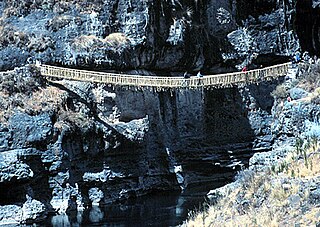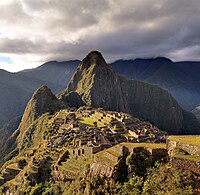
Machu Picchu is a 15th-century Inca citadel located in the Eastern Cordillera of southern Peru on a 2,430-meter (7,970 ft) mountain ridge. Often referred to as the "Lost City of the Incas", it is the most familiar icon of the Inca Empire. It is located in the Machupicchu District within Urubamba Province above the Sacred Valley, which is 80 kilometers (50 mi) northwest of Cusco. The Urubamba River flows past it, cutting through the Cordillera and creating a canyon with a tropical mountain climate.

Pachacuti Inca Yupanqui was the ninth Sapa Inca of the Kingdom of Cusco which he transformed into the Inca Empire. Most archaeologists now believe that the famous Inca site of Machu Picchu was built as an estate for Pachacuti.

Incana rope bridges are simple suspension bridges over canyons, gorges and rivers (pongos) constructed by the Inca Empire. The bridges were an integral part of the Inca road system and exemplify Inca innovation in engineering. Bridges of this type were useful since the Inca people did not use wheeled transport – traffic was limited to pedestrians and livestock – and they were frequently used by chasqui runners delivering messages throughout the Inca Empire.

The Inca road system was the most extensive and advanced transportation system in pre-Columbian South America. It was about 40,000 kilometres (25,000 mi) long. The construction of the roads required a large expenditure of time and effort.

Vilcabamba or Willkapampa is often called the Lost City of the Incas. Vilcabamba means "sacred plain" in Quechua. The modern name for the Inca ruins of Vilcabamba is Espiritu Pampa. Vilcabamba is located in Echarate District of La Convención Province in the Cuzco Region of Peru.

The Sacred Valley of the Incas, or the Urubamba Valley, is a valley in the Andes of Peru, north of the Inca capital of Cusco. It is located in the present-day Peruvian region of Cusco. In colonial documents it was referred to as the "Valley of Yucay." The Sacred Valley was incorporated slowly into the incipient Inca Empire during the period from 1000 to 1400 CE.

The chasquis were the messengers of the Inca empire. Agile, highly trained and physically fit, they were in charge of carrying the quipus, messages and gifts, up to 240 km per day through the chasquis relay system. Chasquis were not just messengers ; instead, chasquis were trained to read and translate the quipus to each other and higher authorities. Not only were they used to transport oral messages, but they also helped the inspector general, the Sapa Inka's brother, keep track of the people in the empire. Chasquis were chosen from the fittest young males and were known to be the fastest runners.

Inca architecture is the most significant pre-Columbian architecture in South America. The Incas inherited an architectural legacy from Tiwanaku, founded in the 2nd century B.C.E. in present-day Bolivia. A core characteristic of the architectural style was to use the topography and existing materials of the land as part of the design. The capital of the Inca empire, Cuzco, still contains many fine examples of Inca architecture, although many walls of Inca masonry have been incorporated into Spanish Colonial structures. The famous royal estate of Machu Picchu is a surviving example of Inca architecture. Other significant sites include Sacsayhuamán and Ollantaytambo. The Incas also developed an extensive road system spanning most of the western length of the continent and placed their distinctive architecture along the way, thereby visually asserting their imperial rule along the frontier.

The Inca society was the society of the Inca civilization in Peru. The Inca Empire, which lasted from 1438 to 1533 A.D., represented the height of this civilization. The Inca state was known as the Kingdom of Cusco before 1438. Over the course of the empire, the rulers used conquest and peaceful assimilation to incorporate a large portion of western South America, centered on the Andes mountain ranges. The empire proved relatively short-lived however: by 1533, Atahualpa, the last Sapa Inca (emperor) of the Inca Empire, was killed on the orders of the conquistador Francisco Pizarro, marking the beginning of Spanish rule. The last Inca stronghold, the Neo-Inca State in Vilcabamba, was conquered by the Spanish in 1572.

The Inca Bridge or Inka Bridge refers to one of two places related to access to Machu Picchu, in Peru.

Choquequirao is an Incan site in southern Peru, similar in structure and architecture to Machu Picchu. The ruins are buildings and terraces at levels above and below Sunch'u Pata, the truncated hill top. The hilltop was anciently leveled and ringed with stones to create a 30 by 50 m platform.

An andén, Spanish for "platform", is a stair-step like terrace dug into the slope of a hillside for agricultural purposes. The term is most often used to refer to the terraces built by pre-Columbian cultures in the Andes mountains of South America. Andenes had several functions, the most important of which was to increase the amount of cultivatable land available to farmers by leveling a planting area for crops. The best known andenes are in Peru, especially in the Sacred Valley near the Inca capital of Cuzco and in the Colca Canyon. Many andenes have survived for more than 500 years and are still in use by farmers throughout the region.

Incan agriculture was the culmination of thousands of years of farming and herding in the high-elevation Andes mountains of South America, the coastal deserts, and the rainforests of the Amazon basin. These three radically different environments were all part of the Inca Empire and required different technologies for agriculture. Inca agriculture was also characterized by the variety of crops grown, the lack of a market system and money, and the unique mechanisms by which the Incas organized their society. Andean civilization was "pristine"—one of five civilizations worldwide which were indigenous and not derivative from other civilizations. Most Andean crops and domestic animals were likewise pristine—not known to other civilizations. Potatoes, tomatoes, chile peppers, and quinoa were among the many unique crops; Camelids and guinea pigs were the unique domesticated animals.
The Incan aqueducts refer to any of a series of aqueducts built by the Inca people. The Inca built such structures to increase arable land and provide drinking water and baths to the population. Due to water scarcity in the Andean region, advanced water management was necessary for the Inca to thrive and expand along much of the coast of Peru. Such structures, some of which survive today, show the advanced hydraulic and civil engineering capabilities of the Inca.

Tambomachay is an archaeological site associated with the Inca Empire, located near Cusco, Peru. An alternate Spanish name is El Baño del Inca.

The Inca Trail to Machu Picchu is a hiking trail in Peru that terminates at Machu Picchu. It consists of three overlapping trails: Mollepata, Classic, and One Day. Mollepata is the longest of the three routes with the highest mountain pass and intersects with the Classic route before crossing Warmiwañusqa. Located in the Andes mountain range, the trail passes through several types of Andean environments including cloud forest and alpine tundra. Settlements, tunnels, and many Incan ruins are located along the trail before ending the terminus at the Sun Gate on Machu Picchu mountain. The two longer routes require an ascent to beyond 4,200 metres (13,800 ft) above sea level, which can result in altitude sickness.

Tipón, is a sprawling early fifteenth-century Inca archaeological park that is situated between 3,250 metres (10,660 ft) and 3,960 metres (12,990 ft) above sea level, located 22 kilometres (14 mi) southeast of Cusco near the village of Tipón. It consists of several ruins enclosed by a powerful defensive wall about 6 kilometres (3.7 mi) long. The most renown part of the park is the group of precise and right angled monumental terraces irrigated by a network of water canals fed by a monumental fountain channeling water from a natural spring. The site includes ancient residential areas and a remarkable amount of petroglyphs in its upper part.

Intihuatana at the archaeological site of Machu Picchu is a notable ritual stone associated with the astronomic clock or calendar of the Inca in South America. Machu Picchu was thought to have been built c. 1450 by the Sapa Inca Pachacuti as a country estate. In the late 16th century, the Viceroy Francisco de Toledo and the clergy destroyed those Intihuatana which they could find. They did so as they believed that the Incas' religion was a blasphemy and the religious significance of the Intihuatana could be a political liability. The Intihuatana of Machu Picchu was found intact by Bingham in 1911, indicating that the Spanish conquerors had not found it. Intihuatana was damaged on September 8, 2000 when a crane being used in an ad shoot toppled over and chipped off a piece of the granite.
The Inca complex at Pisac is a large Incan complex of agricultural terraces, residences, guard posts, watchtowers and a ceremonial/religious centre located along a mountain ridge above the modern town of Pisac in the Sacred Valley of Peru. In 1983 the Pisac National Archeological Park was established to recognize the importance of and to protect the remains of the complex.

During the Inca Empire’s comparatively brief reign, from 1438 to 1533, Inca civilization established an economic structure that allowed for substantial agricultural production as well as cross-community exchange of products. Inca society is considered to have had some of the most successful centrally organized economies in history. Its effectiveness was achieved through the successful control of labor and the regulation of tribute resources. In Inca society, collective labor was the cornerstone for economic productivity and the achieving of common prosperity. People in the ayllu worked together to produce that prosperity. This prosperity caused the Spanish to be amazed by what they saw when they first encountered the Incas in 1528. According to each ayllu, labor was divided by region, with agriculture centralized in the most productive areas; ceramic production, road construction, textile production, and other skills were also part of the ayllus. After local needs were satisfied, the government gathered all surplus that is gathered from ayllus and allocated it where it was needed. People of the Inca Empire received free clothes, food, health care, and schooling in exchange for their labor.

























